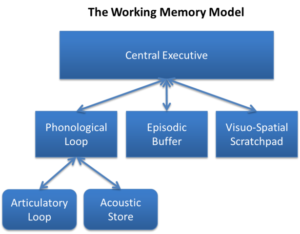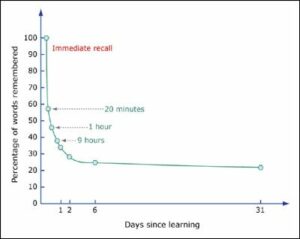By Susan Fein, Instructional Designer, susan.fein@oregonstate.edu
In my role as an instructional designer, the faculty I work with are often looking for ways to increase student engagement and add a “wow” factor to their online course. One way to do that is to add or increase active learning practices.
Active learning requires students to do something and think about what they are doing, rather than simply listening, as with a passive-learning lecture (Bonwell & Eison, 1991). Active learning brings positive and lasting outcomes to students, including better retention and grasp of concepts, and is particularly evident when students work together to develop solutions (Chickering & Gamson, 1987).
Tackling Discussions
 In 2019, I worked with an instructor developing a biochemistry/biophysics course for Ecampus. The instructor loved the peer-to-peer interaction intended for discussions, but was discouraged by the often lackluster exchange commonly demonstrated in the posts. She wanted to liven up these conversations, not only to increase the strength of the community but also to have an impact on the value of the learning that took place.
In 2019, I worked with an instructor developing a biochemistry/biophysics course for Ecampus. The instructor loved the peer-to-peer interaction intended for discussions, but was discouraged by the often lackluster exchange commonly demonstrated in the posts. She wanted to liven up these conversations, not only to increase the strength of the community but also to have an impact on the value of the learning that took place.
Enter knowledge boards! With a simple but creative retooling of the predictable initial-post-and-two-replies format, the instructor found a way to reimagine the often mundane discussion board and transform it into a lively and highly engaging conversation and exchange of knowledge.
How did she do this? Rather than compel all students to respond to a narrow or artificially-constructed prompt, the instructor instead posted several relevant topics or short questions extracted from the concepts presented during that week’s lectures and readings. Topics might be a single word or a short phrase, and the questions were tightly focused and direct.
Choice and Agency
 From this list of 5 to 10 conversation starters that give breadth to the topics, the students can choose which they want to respond to, often selecting what’s of greatest interest to them. These posts could be anything related to the topic or question, so students are free to approach from any perspective or direction.
From this list of 5 to 10 conversation starters that give breadth to the topics, the students can choose which they want to respond to, often selecting what’s of greatest interest to them. These posts could be anything related to the topic or question, so students are free to approach from any perspective or direction.
The instructor found that the students more freely contributed ideas, insights, understandings, questions, confusion, and commentary. They were encouraged to ask questions of each other to delve into significant points. Students could engage in as many conversations as desired, at their discretion. As a result, they tended to be more actively involved, not only with the content and concepts from that week’s materials, but also with each other, producing a strong community of inquiry.
This simple change transformed the tired and (dare I say it?) potentially boring weekly discussion into a meaningful opportunity for a lively and valuable knowledge exchange. The instructor explained that students also report that this knowledge board becomes a study guide, summarizing multiple approaches and insightful content they use for studying, so many revisit the posts even after that week is over as a way to review.
But Wait…There’s More!
The instructor didn’t stop at discussions in her pursuit of increased engagement and active learning. Her next “trick” was to evaluate how the assessments, especially homework problems, were presented.
A typical format in many Ecampus courses is to have students complete homework assignments individually, and these are generally graded on the correctness of the answers. But once again, this instructor redesigned a conventional activity by applying principles of active learning and collaborative pedagogy to improve learning outcomes.
 In the new version, students first answer and submit solutions to the homework individually, and this initial phase is graded on proper application of concepts, rather than on the correctness of the answer. Next, students work together in small groups of 3 or 4 to discuss the same set of problems and, as a group, arrive at consensus of the correct answers.
In the new version, students first answer and submit solutions to the homework individually, and this initial phase is graded on proper application of concepts, rather than on the correctness of the answer. Next, students work together in small groups of 3 or 4 to discuss the same set of problems and, as a group, arrive at consensus of the correct answers.
The active learning “magic” occurs during this critical second phase. If one student is confident about an answer, they present evidence from the lectures and readings to persuade their peers. And when a student is not certain that they correctly grasped the concepts, they discuss the problem and relevant principles, learning from each other through this review, hearing different perspectives and interpretations of the materials. It is through these vital peer-to-peer interactions that the active learning takes place.
As the last phase of the activity, the group submits their answers, which are graded for correctness.
This reshaping of a classic homework activity results in deeper levels of understanding and stronger knowledge retention (Weimer, 2012). And there’s an added benefit for the instructor, too. Since there are fewer papers to grade, formatting homework as a group submission means extra time to offer more and better feedback than would be feasible when grading each student individually. A win-win bonus!
Benefits of Active Learning
 These are just two simple but ingenious ways to reformat classic forms of interaction and assessment.
These are just two simple but ingenious ways to reformat classic forms of interaction and assessment.
Do you have an idea of how you can alter an activity in your course to make it more interesting and engaging? If you sense that your online course could use a boost, consider incorporating more active learning principles to add the extra oomph that could transform your teaching content from mundane to magical!
So let’s close this post in true active learning style and take a moment to reflect. What kinds of active learning practices have you tried in your course? How did those go? We’d love to hear your thoughts and experiences, so please share in comments.
References
Bonwell, C. C., & Eison, J. A. (1991). Active Learning; Creating Excitement in the Classroom (Vol. Education Report No. 1). Washington, D.C.: The George Washington University, School of Education and Human Development.
Chickering, A. W., & Gamson, Z. F. (1987, March). Seven Principles for Good Practice. AAHE Bulletin 39, 3-7.
Weimer, M. (2012, March 27). Five Key Principles of Active Learning. Retrieved from Faculty Focus: https://www.facultyfocus.com/articles/teaching-and-learning/five-key-principles-of-active-learning/






